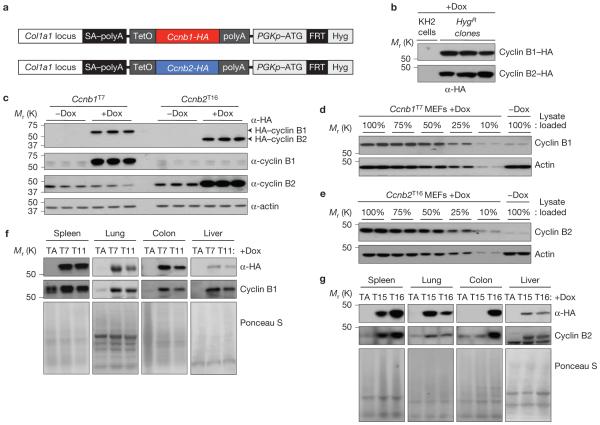Figure 1.
Ccnbl and Ccnb2 transgene production and expression analyses. (a) Generation of wild-type Ccnbl and Ccnb2 transgenic mice: schematic representation of the transgenic strategy. Using recombination at Flp recognition target (FRT) sites, DNA sequences encoding mouse wild-type cyclin Bl or cycl in B2 were inserted downstream of the 3′ untranslated region of the Co/lal locus in KH2 ES cells. SA-polyA, splice acceptor-polyA; Teto, tetracycline operator; PGKp, phosphoglycerate kinase promoter; ATG, start codon. (b) Western blots of lysates from hygromycin B-resistant KH2 ES clones with targeted insertion of HA-Ccnbl or HA-Ccnb2 probed for haemagglutinin (HA). (c) Western blots of extracts from HA-Ccnb1 and HA-Ccnb2 MEFs grown in the presence or absence of dox for 72 h. (d,e) Quantitation of western blots for cyclin B1 or cyclin B2 overexpression (fold change) in MEFs derived from HA-Ccnb1T7 or HA-Ccnb2T16 transgenic strains. (f,g) Western blot analysis of tissue extracts from six-week-old dox-treated HA-Ccnb1 (strains T7 and T11), HA-Ccnb2 (strains T15 and T16) and control (TA) transgenic mice. Ponceau S staining of blotted proteins served as a loading control. Blots in c are representative for three independent experiments, and blots in b and d-g for two independent experiments. Uncropped images of blots are shown in Supplementary Fig. 9.

